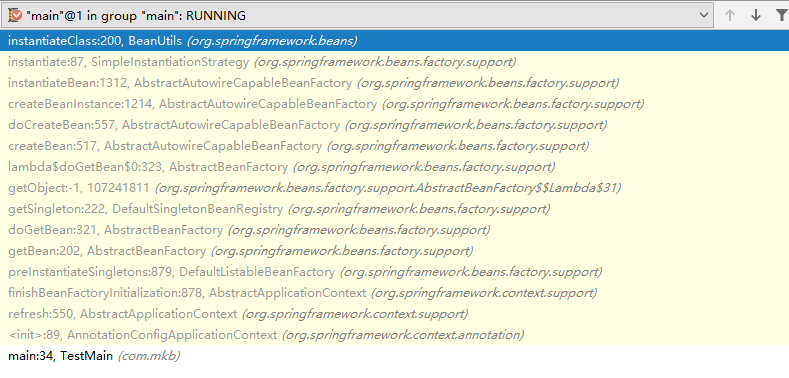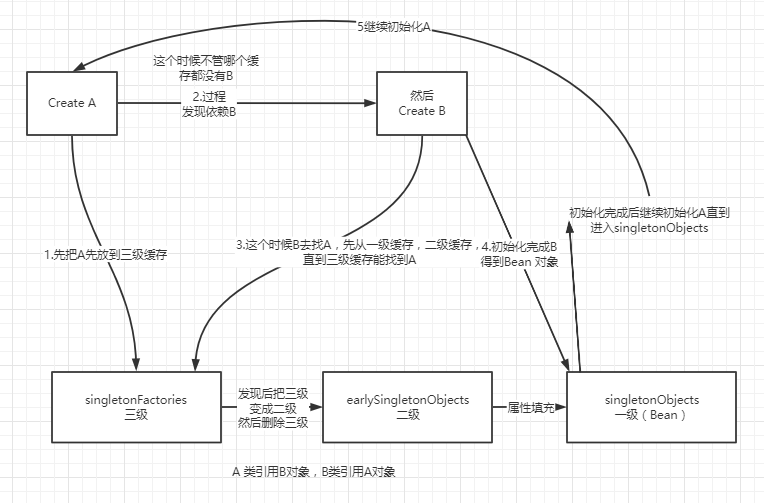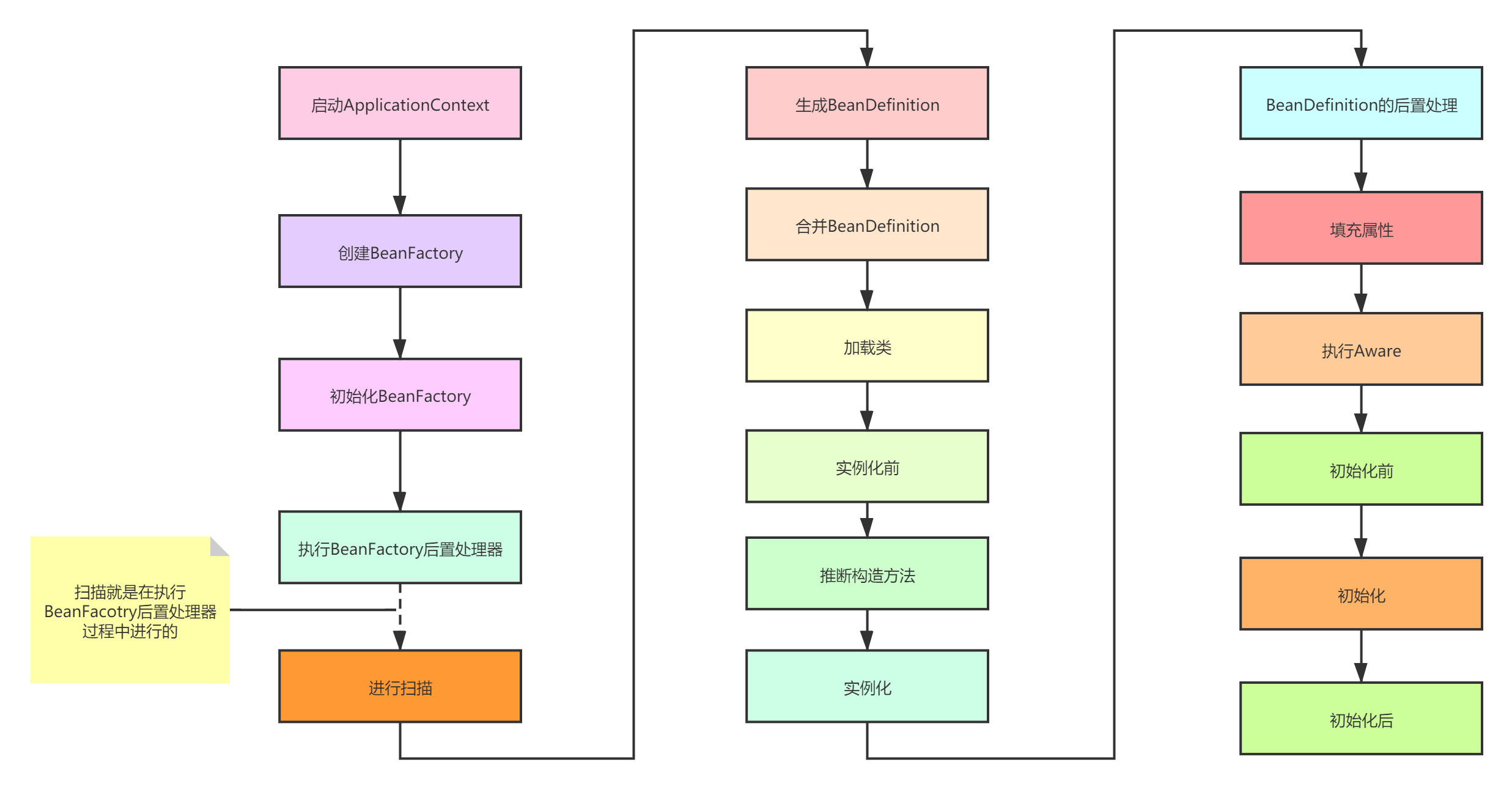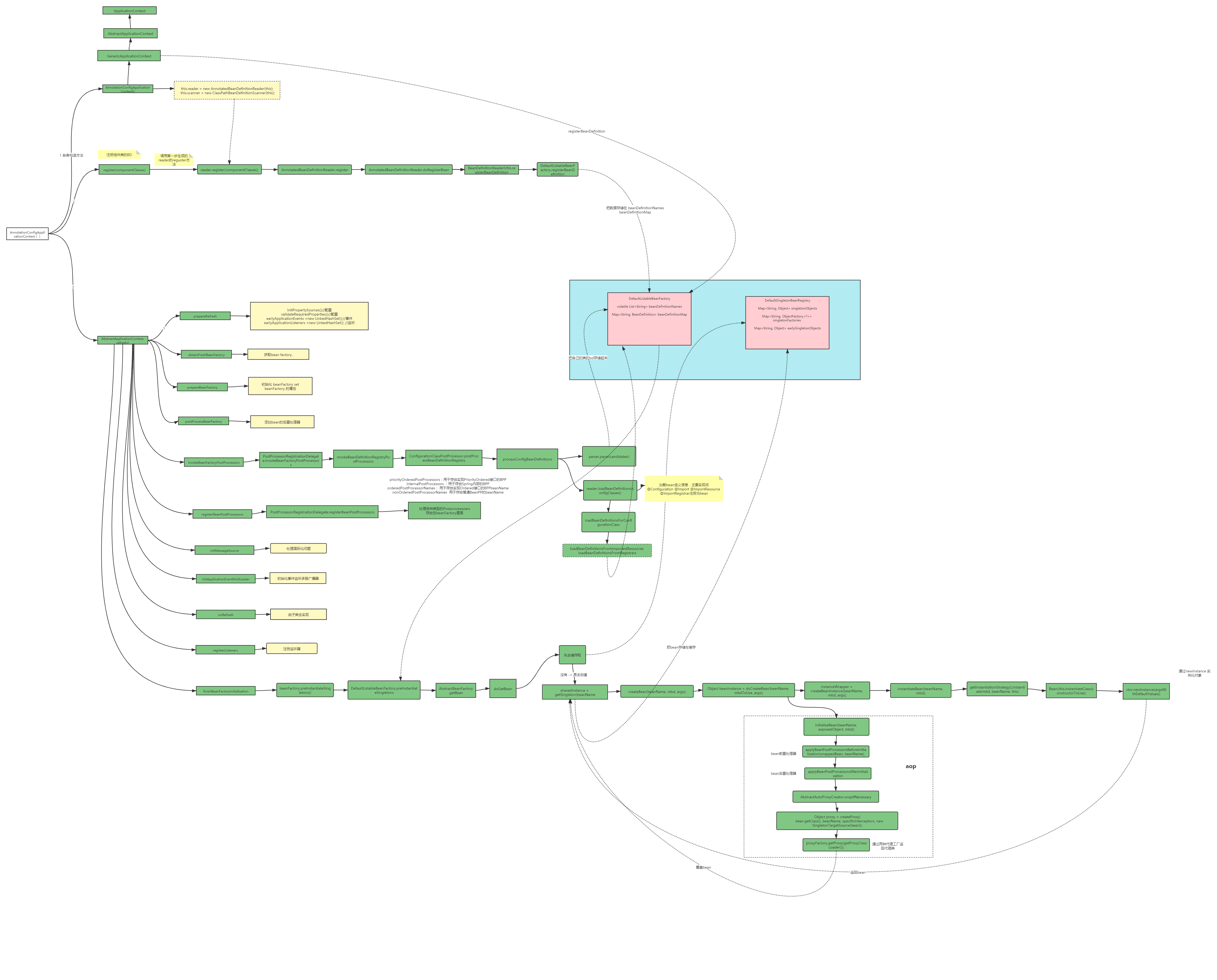源码图
生命周期流程图
Spring IOC Bean生命周期源码
启动spring
public static void main(String[] args) {ApplicationContext ac = new AnnotationConfigApplicationContext(AppConf.class);UserService userService = ac.getBean(UserService.class);userService.fun1();}
进入 ApplicationContext ac = new AnnotationConfigApplicationContext(AppConf.class); 方法
public AnnotationConfigApplicationContext(Class<?>... componentClasses) {this();register(componentClasses);refresh();}
执行过程
进入refresh方法
public void refresh() throws BeansException, IllegalStateException {synchronized (this.startupShutdownMonitor) {// Prepare this context for refreshing.prepareRefresh();// Tell the subclass to refresh the internal bean factory.ConfigurableListableBeanFactory beanFactory = obtainFreshBeanFactory();// Prepare the bean factory for use in this context.prepareBeanFactory(beanFactory);try {// Allows post-processing of the bean factory in context subclasses.postProcessBeanFactory(beanFactory);// Invoke factory processors registered as beans in the context.invokeBeanFactoryPostProcessors(beanFactory);// Register bean processors that intercept bean creation.registerBeanPostProcessors(beanFactory);// Initialize message source for this context.initMessageSource();// Initialize event multicaster for this context.initApplicationEventMulticaster();// Initialize other special beans in specific context subclasses.onRefresh();// Check for listener beans and register them.registerListeners();// Instantiate all remaining (non-lazy-init) singletons.finishBeanFactoryInitialization(beanFactory);// Last step: publish corresponding event.finishRefresh();}catch (BeansException ex) {if (logger.isWarnEnabled()) {logger.warn("Exception encountered during context initialization - " +"cancelling refresh attempt: " + ex);}// Destroy already created singletons to avoid dangling resources.destroyBeans();// Reset 'active' flag.cancelRefresh(ex);// Propagate exception to caller.throw ex;}finally {// Reset common introspection caches in Spring's core, since we// might not ever need metadata for singleton beans anymore...resetCommonCaches();}}}
进入这个方法就是spring ioc 和 aop的 核心 后面有对这些方法的具体分析
进入finishBeanFactoryInitialization(beanFactory);
继续进入
// Instantiate all remaining (non-lazy-init)
singletons.beanFactory.preInstantiateSingletons();
继续进入 getBean(beanName); ——> doGetBean(name, null, null, false);
protected <T> T doGetBean(final String name, @Nullable final Class<T> requiredType,@Nullable final Object[] args, boolean typeCheckOnly) throws BeansException {final String beanName = transformedBeanName(name);Object bean;// Eagerly check singleton cache for manually registered singletons.//去缓存中获取bean 不管是getBean方法还是spring初始化的时候都是使用这个方法//就是都是先从缓存中获取beanObject sharedInstance = getSingleton(beanName);if (sharedInstance != null && args == null) {if (logger.isTraceEnabled()) {if (isSingletonCurrentlyInCreation(beanName)) {logger.trace("Returning eagerly cached instance of singleton bean '" + beanName +"' that is not fully initialized yet - a consequence of a circular reference");}else {logger.trace("Returning cached instance of singleton bean '" + beanName + "'");}}bean = getObjectForBeanInstance(sharedInstance, name, beanName, null);}else {// Fail if we're already creating this bean instance:// We're assumably within a circular reference.if (isPrototypeCurrentlyInCreation(beanName)) {throw new BeanCurrentlyInCreationException(beanName);}// Check if bean definition exists in this factory.BeanFactory parentBeanFactory = getParentBeanFactory();if (parentBeanFactory != null && !containsBeanDefinition(beanName)) {// Not found -> check parent.String nameToLookup = originalBeanName(name);if (parentBeanFactory instanceof AbstractBeanFactory) {return ((AbstractBeanFactory) parentBeanFactory).doGetBean(nameToLookup, requiredType, args, typeCheckOnly);}else if (args != null) {// Delegation to parent with explicit args.return (T) parentBeanFactory.getBean(nameToLookup, args);}else if (requiredType != null) {// No args -> delegate to standard getBean method.return parentBeanFactory.getBean(nameToLookup, requiredType);}else {return (T) parentBeanFactory.getBean(nameToLookup);}}if (!typeCheckOnly) {markBeanAsCreated(beanName);}try {final RootBeanDefinition mbd = getMergedLocalBeanDefinition(beanName);checkMergedBeanDefinition(mbd, beanName, args);// Guarantee initialization of beans that the current bean depends on.String[] dependsOn = mbd.getDependsOn();if (dependsOn != null) {for (String dep : dependsOn) {if (isDependent(beanName, dep)) {throw new BeanCreationException(mbd.getResourceDescription(), beanName,"Circular depends-on relationship between '" + beanName + "' and '" + dep + "'");}registerDependentBean(dep, beanName);try {getBean(dep);}catch (NoSuchBeanDefinitionException ex) {throw new BeanCreationException(mbd.getResourceDescription(), beanName,"'" + beanName + "' depends on missing bean '" + dep + "'", ex);}}}// Create bean instance.if (mbd.isSingleton()) {sharedInstance = getSingleton(beanName, () -> {try {return createBean(beanName, mbd, args);}catch (BeansException ex) {// Explicitly remove instance from singleton cache: It might have been put there// eagerly by the creation process, to allow for circular reference resolution.// Also remove any beans that received a temporary reference to the bean.destroySingleton(beanName);throw ex;}});bean = getObjectForBeanInstance(sharedInstance, name, beanName, mbd);}......}
先去缓存中获取bean 不管是getBean方法还是spring初始化的时候都是使用这个方法
就是都是先从缓存(map)中获取bean 源码如下:
protected Object getSingleton(String beanName, boolean allowEarlyReference) {Object singletonObject = this.singletonObjects.get(beanName);if (singletonObject == null && isSingletonCurrentlyInCreation(beanName)) {synchronized (this.singletonObjects) {singletonObject = this.earlySingletonObjects.get(beanName);if (singletonObject == null && allowEarlyReference) {ObjectFactory<?> singletonFactory = this.singletonFactories.get(beanName);if (singletonFactory != null) {singletonObject = singletonFactory.getObject();this.earlySingletonObjects.put(beanName, singletonObject);this.singletonFactories.remove(beanName);}}}}return singletonObject;}
首先看到的是从cache中获取这个单例的bean,这个缓存就是singletonObjects。如果获取不到,并且对象正在创建中,就再从二级缓存earlySingletonObjects中获取。如果还是获取不到且允许singletonFactories通过getObject()获取,就从三级缓存singletonFactory.getObject()(三级缓存)获取,如果获取到了则:从singletonFactories中移除,并放入earlySingletonObjects中。其实也就是从三级缓存移动到了二级缓存。
如果bean没有生产,通过doGetBean 内部的下面的方法getSingleton 实例化一个bean对象,getSingleton获取bean对象后就会存储到缓存中
getSingleton —> addSingleton 方法
protected void addSingleton(String beanName, Object singletonObject) {synchronized (this.singletonObjects) {this.singletonObjects.put(beanName, singletonObject);this.singletonFactories.remove(beanName);this.earlySingletonObjects.remove(beanName);this.registeredSingletons.add(beanName);}}
初始化第一步的时候,会把对象放到三级缓存,等下一个对象循环引用的时候变成二级缓存,然后生成bean的时候,把三级和二级全部删除。
再实例化的时候 会先获取bean的RootBeanDefinition 这个RootBeanDefinition 也很重要(以后单独讲解),这里就是单纯的理解bean初始换的过程中会把bean的信息列入class ,name,params,singleton等等,很多信息都分装到一个对象,然后存储在缓存中
if (mbd.isSingleton()) {sharedInstance = getSingleton(beanName, () -> {try {return createBean(beanName, mbd, args);}catch (BeansException ex) {// Explicitly remove instance from singleton cache: It might have been put there// eagerly by the creation process, to allow for circular reference resolution.// Also remove any beans that received a temporary reference to the bean.destroySingleton(beanName);throw ex;}});bean = getObjectForBeanInstance(sharedInstance, name, beanName, mbd);}
进入getSingleton
public Object getSingleton(String beanName, ObjectFactory<?> singletonFactory) {Assert.notNull(beanName, "Bean name must not be null");synchronized (this.singletonObjects) {Object singletonObject = this.singletonObjects.get(beanName);if (singletonObject == null) {if (this.singletonsCurrentlyInDestruction) {throw new BeanCreationNotAllowedException(beanName,"Singleton bean creation not allowed while singletons of this factory are in destruction " +"(Do not request a bean from a BeanFactory in a destroy method implementation!)");}if (logger.isDebugEnabled()) {logger.debug("Creating shared instance of singleton bean '" + beanName + "'");}beforeSingletonCreation(beanName);boolean newSingleton = false;boolean recordSuppressedExceptions = (this.suppressedExceptions == null);if (recordSuppressedExceptions) {this.suppressedExceptions = new LinkedHashSet<>();}try {singletonObject = singletonFactory.getObject();newSingleton = true;}catch (IllegalStateException ex) {// Has the singleton object implicitly appeared in the meantime ->// if yes, proceed with it since the exception indicates that state.singletonObject = this.singletonObjects.get(beanName);if (singletonObject == null) {throw ex;}}catch (BeanCreationException ex) {if (recordSuppressedExceptions) {for (Exception suppressedException : this.suppressedExceptions) {ex.addRelatedCause(suppressedException);}}throw ex;}finally {if (recordSuppressedExceptions) {this.suppressedExceptions = null;}afterSingletonCreation(beanName);}if (newSingleton) {addSingleton(beanName, singletonObject);}}return singletonObject;}}
代码太长 看重点,就是 singletonObject = singletonFactory.getObject(); 这行代码获取了bean的实例,这个是jdk1.8的方法引用语法(ps:要想看懂spring 对jdk1.8要有了解,并且熟悉常用设计模式),这个方法其实就是调用 getSingleton 的 createBean(beanName, mbd, args); 这个方法。
进入createBean(beanName, mbd, args);
protected Object createBean(String beanName, RootBeanDefinition mbd, @Nullable Object[] args)throws BeanCreationException {if (logger.isTraceEnabled()) {logger.trace("Creating instance of bean '" + beanName + "'");}RootBeanDefinition mbdToUse = mbd;// Make sure bean class is actually resolved at this point, and// clone the bean definition in case of a dynamically resolved Class// which cannot be stored in the shared merged bean definition.Class<?> resolvedClass = resolveBeanClass(mbd, beanName);if (resolvedClass != null && !mbd.hasBeanClass() && mbd.getBeanClassName() != null) {mbdToUse = new RootBeanDefinition(mbd);mbdToUse.setBeanClass(resolvedClass);}// Prepare method overrides.try {mbdToUse.prepareMethodOverrides();}catch (BeanDefinitionValidationException ex) {throw new BeanDefinitionStoreException(mbdToUse.getResourceDescription(),beanName, "Validation of method overrides failed", ex);}try {// Give BeanPostProcessors a chance to return a proxy instead of the target bean instance.Object bean = resolveBeforeInstantiation(beanName, mbdToUse);if (bean != null) {return bean;}}catch (Throwable ex) {throw new BeanCreationException(mbdToUse.getResourceDescription(), beanName,"BeanPostProcessor before instantiation of bean failed", ex);}try {Object beanInstance = doCreateBean(beanName, mbdToUse, args);if (logger.isTraceEnabled()) {logger.trace("Finished creating instance of bean '" + beanName + "'");}return beanInstance;}catch (BeanCreationException | ImplicitlyAppearedSingletonException ex) {// A previously detected exception with proper bean creation context already,// or illegal singleton state to be communicated up to DefaultSingletonBeanRegistry.throw ex;}catch (Throwable ex) {throw new BeanCreationException(mbdToUse.getResourceDescription(), beanName, "Unexpected exception during bean creation", ex);}}
看重点,就是在Object beanInstance = doCreateBean(beanName, mbdToUse, args); 这个方法内部产生了bean,
进入doCreateBean 内部
protected Object doCreateBean(final String beanName, final RootBeanDefinition mbd, final @Nullable Object[] args)throws BeanCreationException {// Instantiate the bean.BeanWrapper instanceWrapper = null;if (mbd.isSingleton()) {instanceWrapper = this.factoryBeanInstanceCache.remove(beanName);}if (instanceWrapper == null) {instanceWrapper = createBeanInstance(beanName, mbd, args);}final Object bean = instanceWrapper.getWrappedInstance();Class<?> beanType = instanceWrapper.getWrappedClass();if (beanType != NullBean.class) {mbd.resolvedTargetType = beanType;}// Allow post-processors to modify the merged bean definition.synchronized (mbd.postProcessingLock) {if (!mbd.postProcessed) {try {applyMergedBeanDefinitionPostProcessors(mbd, beanType, beanName);}catch (Throwable ex) {throw new BeanCreationException(mbd.getResourceDescription(), beanName,"Post-processing of merged bean definition failed", ex);}mbd.postProcessed = true;}}// Eagerly cache singletons to be able to resolve circular references// even when triggered by lifecycle interfaces like BeanFactoryAware.boolean earlySingletonExposure = (mbd.isSingleton() && this.allowCircularReferences &&isSingletonCurrentlyInCreation(beanName));if (earlySingletonExposure) {if (logger.isTraceEnabled()) {logger.trace("Eagerly caching bean '" + beanName +"' to allow for resolving potential circular references");}addSingletonFactory(beanName, () -> getEarlyBeanReference(beanName, mbd, bean));}// Initialize the bean instance.Object exposedObject = bean;try {populateBean(beanName, mbd, instanceWrapper);exposedObject = initializeBean(beanName, exposedObject, mbd);}catch (Throwable ex) {if (ex instanceof BeanCreationException && beanName.equals(((BeanCreationException) ex).getBeanName())) {throw (BeanCreationException) ex;}else {throw new BeanCreationException(mbd.getResourceDescription(), beanName, "Initialization of bean failed", ex);}}if (earlySingletonExposure) {Object earlySingletonReference = getSingleton(beanName, false);if (earlySingletonReference != null) {if (exposedObject == bean) {exposedObject = earlySingletonReference;}else if (!this.allowRawInjectionDespiteWrapping && hasDependentBean(beanName)) {String[] dependentBeans = getDependentBeans(beanName);Set<String> actualDependentBeans = new LinkedHashSet<>(dependentBeans.length);for (String dependentBean : dependentBeans) {if (!removeSingletonIfCreatedForTypeCheckOnly(dependentBean)) {actualDependentBeans.add(dependentBean);}}if (!actualDependentBeans.isEmpty()) {throw new BeanCurrentlyInCreationException(beanName,"Bean with name '" + beanName + "' has been injected into other beans [" +StringUtils.collectionToCommaDelimitedString(actualDependentBeans) +"] in its raw version as part of a circular reference, but has eventually been " +"wrapped. This means that said other beans do not use the final version of the " +"bean. This is often the result of over-eager type matching - consider using " +"'getBeanNamesOfType' with the 'allowEagerInit' flag turned off, for example.");}}}}// Register bean as disposable.try {registerDisposableBeanIfNecessary(beanName, bean, mbd);}catch (BeanDefinitionValidationException ex) {throw new BeanCreationException(mbd.getResourceDescription(), beanName, "Invalid destruction signature", ex);}return exposedObject;}
就是 instanceWrapper = createBeanInstance(beanName, mbd, args); 这个方法实例化了bean对象
进入createBeanInstance 方法
protected BeanWrapper createBeanInstance(String beanName, RootBeanDefinition mbd, @Nullable Object[] args) {
// Make sure bean class is actually resolved at this point.
Class<?> beanClass = resolveBeanClass(mbd, beanName);
if (beanClass != null && !Modifier.isPublic(beanClass.getModifiers()) && !mbd.isNonPublicAccessAllowed()) {
throw new BeanCreationException(mbd.getResourceDescription(), beanName,
"Bean class isn't public, and non-public access not allowed: " + beanClass.getName());
}
Supplier<?> instanceSupplier = mbd.getInstanceSupplier();
if (instanceSupplier != null) {
return obtainFromSupplier(instanceSupplier, beanName);
}
if (mbd.getFactoryMethodName() != null) {
return instantiateUsingFactoryMethod(beanName, mbd, args);
}
// Shortcut when re-creating the same bean...
boolean resolved = false;
boolean autowireNecessary = false;
if (args == null) {
synchronized (mbd.constructorArgumentLock) {
if (mbd.resolvedConstructorOrFactoryMethod != null) {
resolved = true;
autowireNecessary = mbd.constructorArgumentsResolved;
}
}
}
if (resolved) {
if (autowireNecessary) {
return autowireConstructor(beanName, mbd, null, null);
}
else {
return instantiateBean(beanName, mbd);
}
}
// Candidate constructors for autowiring?
Constructor<?>[] ctors = determineConstructorsFromBeanPostProcessors(beanClass, beanName);
if (ctors != null || mbd.getResolvedAutowireMode() == AUTOWIRE_CONSTRUCTOR ||
mbd.hasConstructorArgumentValues() || !ObjectUtils.isEmpty(args)) {
return autowireConstructor(beanName, mbd, ctors, args);
}
// Preferred constructors for default construction?
ctors = mbd.getPreferredConstructors();
if (ctors != null) {
return autowireConstructor(beanName, mbd, ctors, null);
}
// No special handling: simply use no-arg constructor.
return instantiateBean(beanName, mbd);
}
直接进入重点 instantiateBean 这个方法
进入instantiateBean
protected BeanWrapper instantiateBean(final String beanName, final RootBeanDefinition mbd) {
try {
Object beanInstance;
final BeanFactory parent = this;
if (System.getSecurityManager() != null) {
beanInstance = AccessController.doPrivileged((PrivilegedAction<Object>) () ->
getInstantiationStrategy().instantiate(mbd, beanName, parent),
getAccessControlContext());
}
else {
beanInstance = getInstantiationStrategy().instantiate(mbd, beanName, parent);
}
BeanWrapper bw = new BeanWrapperImpl(beanInstance);
initBeanWrapper(bw);
return bw;
}
catch (Throwable ex) {
throw new BeanCreationException(
mbd.getResourceDescription(), beanName, "Instantiation of bean failed", ex);
}
}
直接进入beanInstance = getInstantiationStrategy().instantiate(mbd, beanName, parent); 这个方法的 instantiate方法
public Object instantiate(RootBeanDefinition bd, @Nullable String beanName, BeanFactory owner) {
// Don't override the class with CGLIB if no overrides.
if (!bd.hasMethodOverrides()) {
Constructor<?> constructorToUse;
synchronized (bd.constructorArgumentLock) {
constructorToUse = (Constructor<?>) bd.resolvedConstructorOrFactoryMethod;
if (constructorToUse == null) {
final Class<?> clazz = bd.getBeanClass();
if (clazz.isInterface()) {
throw new BeanInstantiationException(clazz, "Specified class is an interface");
}
try {
if (System.getSecurityManager() != null) {
constructorToUse = AccessController.doPrivileged(
(PrivilegedExceptionAction<Constructor<?>>) clazz::getDeclaredConstructor);
}
else {
constructorToUse = clazz.getDeclaredConstructor();
}
bd.resolvedConstructorOrFactoryMethod = constructorToUse;
}
catch (Throwable ex) {
throw new BeanInstantiationException(clazz, "No default constructor found", ex);
}
}
}
return BeanUtils.instantiateClass(constructorToUse);
}
else {
// Must generate CGLIB subclass.
return instantiateWithMethodInjection(bd, beanName, owner);
}
}
可以看到是调用BeanUtils.instantiateClass(constructorToUse); 这个方法返回了 bean对象。
进入instantiateClass
public static <T> T instantiateClass(Constructor<T> ctor, Object... args) throws BeanInstantiationException {
Assert.notNull(ctor, "Constructor must not be null");
try {
ReflectionUtils.makeAccessible(ctor);
if (KotlinDetector.isKotlinReflectPresent() && KotlinDetector.isKotlinType(ctor.getDeclaringClass())) {
return KotlinDelegate.instantiateClass(ctor, args);
}
else {
Class<?>[] parameterTypes = ctor.getParameterTypes();
Assert.isTrue(args.length <= parameterTypes.length, "Can't specify more arguments than constructor parameters");
Object[] argsWithDefaultValues = new Object[args.length];
for (int i = 0 ; i < args.length; i++) {
if (args[i] == null) {
Class<?> parameterType = parameterTypes[i];
argsWithDefaultValues[i] = (parameterType.isPrimitive() ? DEFAULT_TYPE_VALUES.get(parameterType) : null);
}
else {
argsWithDefaultValues[i] = args[i];
}
}
return ctor.newInstance(argsWithDefaultValues);
}
}
catch (InstantiationException ex) {
throw new BeanInstantiationException(ctor, "Is it an abstract class?", ex);
}
catch (IllegalAccessException ex) {
throw new BeanInstantiationException(ctor, "Is the constructor accessible?", ex);
}
catch (IllegalArgumentException ex) {
throw new BeanInstantiationException(ctor, "Illegal arguments for constructor", ex);
}
catch (InvocationTargetException ex) {
throw new BeanInstantiationException(ctor, "Constructor threw exception", ex.getTargetException());
}
}
return ctor.newInstance(argsWithDefaultValues); 这个就是通过反射来实例化bean对象。
这里先解释一下三级缓存的问题,使用三级缓存,解决了循环依赖的问题,具体原理如下。
singletonFactories : 单例对象工厂的cache
earlySingletonObjects :提前暴光的单例对象的Cache
singletonObjects:单例对象的cache
从上面三级缓存的分析,我们可以知道,Spring解决循环依赖的诀窍就在于singletonFactories这个三级cache。这个cache的类型是ObjectFactory。这里就是解决循环依赖的关键,发生在createBeanInstance之后,也就是说单例对象此时已经被创建出来(调用了构造器)。这个对象已经被生产出来了,虽然还不完美(还没有进行初始化的第二步和第三步),但是已经能被人认出来了(根据对象引用能定位到堆中的对象),所以Spring此时将这个对象提前曝光出来让大家认识,让大家使用。
这样做有什么好处呢?让我们来分析一下“A的某个field或者setter依赖了B的实例对象,同时B的某个field或者setter依赖了A的实例对象”这种循环依赖的情况。A首先完成了初始化的第一步,并且将自己提前曝光到singletonFactories中,此时进行初始化的第二步,发现自己依赖对象B,此时就尝试去get(B),发现B还没有被create,所以走create流程,B在初始化第一步的时候发现自己依赖了对象A,于是尝试get(A),尝试一级缓存singletonObjects(肯定没有,因为A还没初始化完全),尝试二级缓存earlySingletonObjects(也没有),尝试三级缓存singletonFactories,由于A通过ObjectFactory将自己提前曝光了,所以B能够通过ObjectFactory.getObject拿到A对象(虽然A还没有初始化完全,但是总比没有好呀),B拿到A对象后顺利完成了初始化阶段1、2、3,完全初始化之后将自己放入到一级缓存singletonObjects中。此时返回A中,A此时能拿到B的对象顺利完成自己的初始化阶段2、3,最终A也完成了初始化,进去了一级缓存singletonObjects中,而且更加幸运的是,由于B拿到了A的对象引用,所以B现在hold住的A对象完成了初始化。
原理图:
总结:初始化bean的大体流程就是这样,其中涉及很多重要的方法,以后会单独详解。



